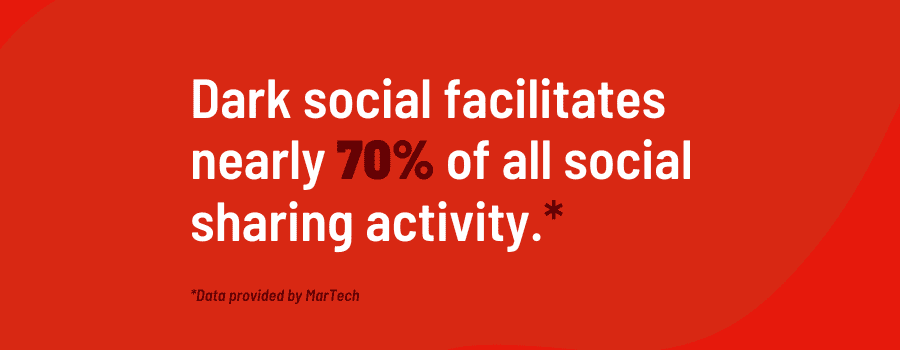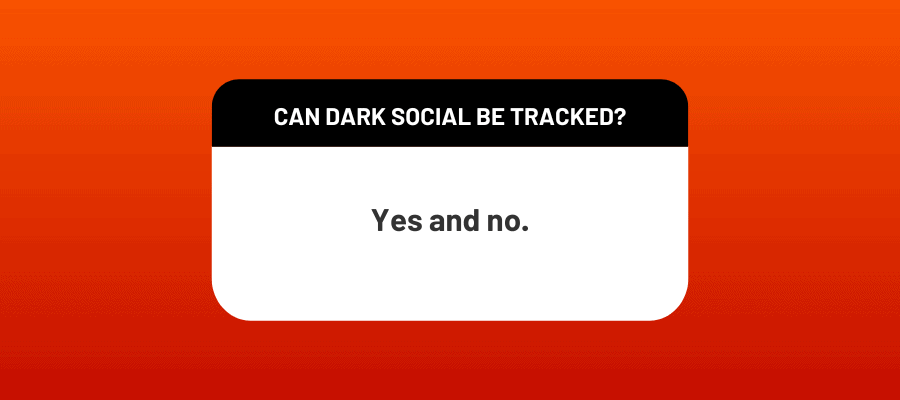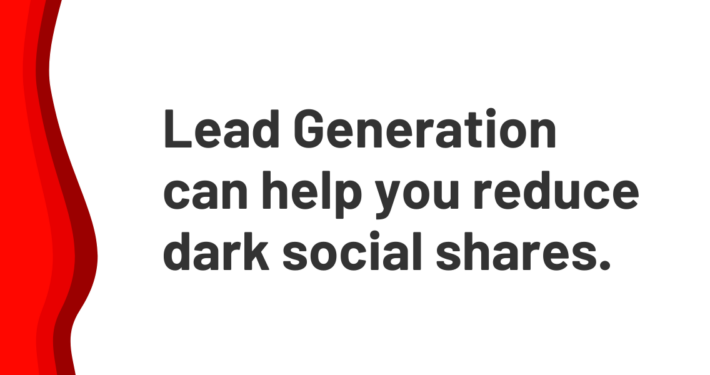
An important aspect of social media marketing involves tracking your efforts across various channels like Facebook, Instagram, LinkedIn, Twitter, and anywhere else you post. You need to know what people are reading, clicking, and shying away from so you can allocate the proper marketing budget for each channel.
There’s only one thing standing in your way—dark social.
What Is Dark Social?
The term “dark social” might sound ominous, but it’s really just more of an inconvenience to your marketing strategy. The term comes from an article published in The Atlantic titled Dark Social: We Have the Whole History of the Web Wrong and it’s a reference to the unseen content sharing that happens through private channels like social media, groups, podcasts, emails, text messages, and messaging applications.
Content shared over these private channels is difficult and sometimes impossible to track. In contrast, other channels can be tracked directly. For instance, with the right software, you can see where your website visitors come from, which email subscribers are opening your marketing emails, and who is clicking on links. With these channels, tracking is almost always built in. That isn’t the case with most social media channels.
Tracking this data is critical for refining your marketing strategy. If you can’t track how people are interacting with your content, you’re missing out on a whole lot of data that would otherwise help improve your results. That’s the problem with dark social, but there are solutions.

People share content all day long across the channels they visit most. There’s never a moment when URLs and other content isn’t being shared in some manner. However, the majority of that sharing goes untracked.
Focusing on dark social is more important than you might think. Alexis Madrigal, the writer who invented the term, found that 69% of social referral traffic comes from dark social. Additional data sourced by MarTech shows that 32% of people only share privately. That means that no matter how much you track, you’re still missing most of your social media marketing data. It doesn’t have to be this way, at least not completely.

By now, you’re probably wondering if there’s any way to track dark social, and there isn’t a simple answer. The truth is that sometimes you can, but not always. If you’re hoping to track shares using tools native to each channel, that may not be possible. It all depends on the particular channel and whether the software developers programmed it for attribution tracking.
For example, mobile apps don’t always pass referral information, but that’s easily remedied by the developers. The question is simply whether or not they’ll incorporate referral tracking into future releases.
If you’re open to third-party tracking tools, using a URL shortener (like bit.ly) makes it possible to track shares across dark social. Using this method can provide you with quite a bit of data regarding user behavior.
There are also ways to track content that gets copied and shared by including a link back to the source when that content is pasted. You can also ensure that when a URL gets copied from the address bar, a special tracking code is inserted when the link is pasted somewhere else. Some people will remove these tracking codes, however, so although it’s extremely useful, it’s never going to be perfect.
You can increase trackable shares by focusing more on lead generation than demand generation. Both are important, but when your focus is on the latter, most of your traffic will come from dark social simply because you aren’t pulling people into your marketing funnel. Placing an emphasis on lead generation brings people into a trackable space and reduces the impact of dark social on your marketing efforts.

You can increase trackable shares by focusing more on lead generation than demand generation. Both are important, but when your focus is on the latter, most of your traffic will come from dark social simply because you aren’t pulling people into your marketing funnel. Placing an emphasis on lead generation brings people into a trackable space and reduces the impact of dark social on your marketing efforts.
It’s not that lead generation stops people from sharing your content on dark social channels. This will always happen to a large degree. However, as you focus more on generating leads, you’ll be directing people into your digital marketing funnels, where you’ll then be able to track the efficacy of your marketing strategy. If you don’t get people into your funnel, they will remain untraceable and you’ll never know if your efforts are producing results. Those people might buy your product later on, but if they aren’t in your funnel you’ll never know. When you can’t measure the results of your marketing efforts, you won’t know how much money you’re wasting. For instance, some social channels might not even be worth your time to invest in, and you’d never know it when you can’t see the data.
Examples of Dark Social
Now that you know what dark social is and why it makes tracking user behavior difficult (or impossible), here are some examples of the most common dark social sources.
Social Media Platforms and Messaging Apps
People spend a lot of time communicating on social media platforms, including messaging apps. Here’s a list of some of those channels:
Without the use of third-party tools, like link shorteners, you can’t easily track what people share across these platforms.
Communications in the Physical World
While the term “dark social” sounds like it’s only relevant through social platforms, it can be used in the physical world as well. Here are a few examples of how they can be performed in real life:
Word of mouth — It’s not possible to digitally track word of mouth. However, you can implement some kind of referral program that provides an incentive for people to give others a special link that will attribute new leads and visits to that person.
For example, how many times have you had a friend ask you if you’ve seen a viral social post or video? This is an example of dark social in the physical world because even if you didn’t hear about the content through social media, a friend alerts you of it. Then, you more than likely will go an find it for yourself.
Conferences and networking gatherings — When your event organizers and participants share information during in-person events, this can’t be tracked easily because it all happens offline. As with word of mouth, you can implement a method to track shares that come from events by using affiliate links, but you need to give people incentive to always use their referral link. This requires creating an affiliate program and might be more than what you’re able to create on your own.
How to Identify Sources of Dark Social
It should be clear by now that you need to track dark social to the best of your ability, and the first step is identifying the sources.
Here are some of the main ways B2B marketers can identify sources of dark social:
- Data collection: Collect qualitative data from leads and customers (such as asking “how did you hear about us?” questions on contact forms).
- URL shorteners: Use tools to shorten long tracking URLs; this can be done by using link shorteners like bit.ly or adding social sharing links on blogs and articles.
- Third-party tools: Invest in dark social tracking software, like GetSocial.io. You can also use ShareThis to add inline sharing buttons to your content so people can share it (with attribution) on various communication platforms.
Future channels will need inherent tracking capabilities.
Now that people are becoming more aware of dark social, it stands to reason that developers will start incorporating tracking capabilities into their applications, especially as new social channels emerge.
Why Does Dark Social Matter?
Dark social disrupts the accuracy of attribution tracking.
Untraceable sharing causes inconsistency in direct traffic spikes and therefore impacts your pipeline, revenue, and other aspects of your business that rely on data to accurately assess.
Dark social creates the motivation to hammer down on lead generation.
There’s no denying that generating leads is hard work, and that may be why so many businesses focus most of their attention on demand generation instead. It’s easier and seems to get more immediate results in terms of engagement, but it also increases dark social.
As demand generation becomes a business’s dominant marketing strategy, dark social will continue to rise, and marketing operations will become more important (like campaign and attribution tracking).
Your most influential marketing strategies contribute to dark social.
Webinars, influencer marketing, partnership marketing, podcasts, etc. all contribute to dark social. If you’re using any of these tactics, your traffic from dark social will be impacted. To measure the impact of partnership marketing tactics, you’ll need to prioritize campaign attribution.
Key Takeaways
No matter how much effort you put into tracking how your content is shared and consumed online, you’ll always fall short of getting the full picture when dark social is the source for most of that activity.
Dark social isn’t bad, it’s just the result of people privately sharing information online, and if you want to get the most out of your digital marketing campaigns, you need to find ways to track your content as it’s shared across those dark channels.
Tracking social attribution is a necessity when you want to see the impact of your investment in social marketing. You need accurate data in order to make informed business decisions regarding how you spend your marketing budget.
Put simply, dark social makes it hard to know what works and what doesn’t. If you don’t start tracking dark social, you’re going to miss the majority of data that will tell you if your marketing dollars are well spent.


